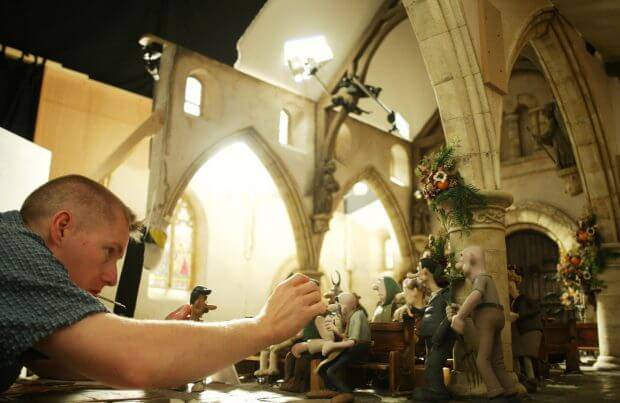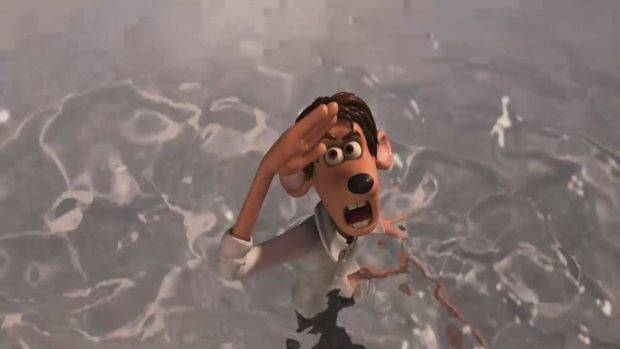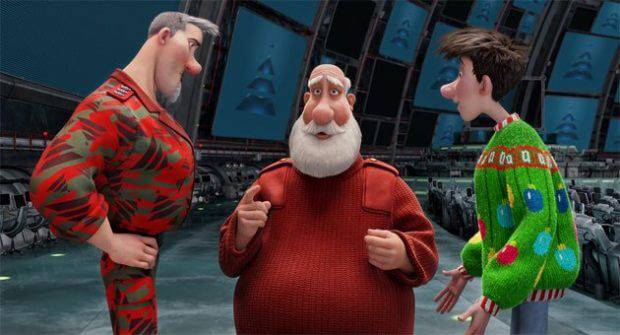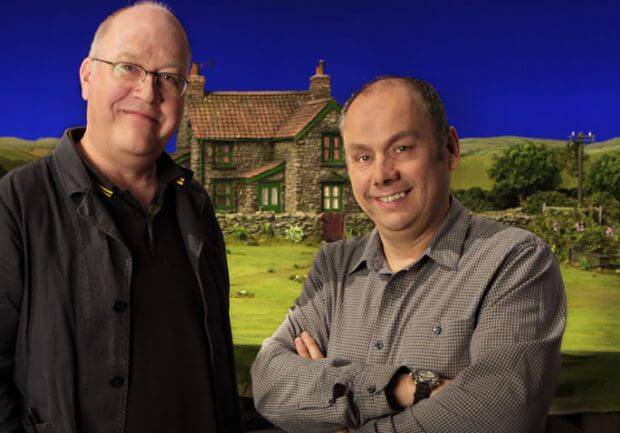Aardman Week – Features
Stop-motion animated feature films used to be rare. It’s not unusual now for multiple films using the technique to release in one year, but in the mid 90’s, Aardman were facing untrampled snow.
In 1993, Touchstone released The Nightmare Before Christmas, raising the standard of the medium and proving that it could perform well commercially. The same year, The Wrong Trousers debuted to roaring success. At the time, A Close Shave was in development, and being considered as a feature-length production, but they weren’t ready- The crew was only around 30 people. 200 were required when they eventually did embark on a feature.
Pathé began financing Chicken Run’s development in 1996, with unofficial mentorship from the newly-formed DreamWorks. The film’s preproduction would not fully gestate for another two years, but in 1997, a deal to co-finance and distribute Chicken Run with DreamWorks and Pathé was solidified, with DreamWorks on board for a further 4 films.
An inconspicuous warehouse near Bristol filled with gallons of rubber, plasticine, and paint. Mixed with the blood, sweat and tears of the crew, these materials formed the most successful stop-motion animated film to date, at under half the budget of it’s mainstream contemporaries (The Emperor’s New Groove, Titan AE, The Road to El Dorado).
They were set up and ready to go on the next film- Wallace and Gromit: The Curse of the Were-Rabbit. Nick Park continued to co-direct his iconic characters alongside Steve Box, who had animated them previously, as well as directing the incredible 1997 short film Stage Fright.
This film saw the expansion of Wallace and Gromit’s cosy world, and set the cheeky, uncynical humor of the shorts in some of the most beautiful miniature environments you’ll ever see.
Despite winning 2005’s ‘Best animated feature’ Oscar, the film did not perform as well as expected by DreamWorks. Still, I consider 2005 the beginning of the current, incredible era of stop-motion animation- Corpse Bride was also released that year, also animated in the UK, and in the USA Laika was established.
With the stop-motion production system in full swing making The Were-Rabbit, Aardman began expanding in another direction. They created their first CG-animated feature, after gaining confidence with the technique on various commercials and short films. The New York Times described Aardman’s relationship with DreamWorks during the making of Flushed Away as a “creative tussle” and claimed that DreamWorks were imposing too much creative control upon Aardman. A few days before Flushed Away released in November 2006, it was announced that the studios’ collaboration would not continue for the full 5 films as previously expected.
At the time, a film was in development with John Cleese co-writing, called Crood Awakening. When the companies parted ways, the project belonged to DreamWorks, and it eventually became the 2013 film The Croods. The 5th film was being developed by Richard Starzak, but never made it beyond its early phase. There were also rumours of another Nick Park/Steve Box collaboration in the shape of The Cat Burglars – a heist caper where cats plan to steal milk from milkmen.
Aardman were soon signed up to a 3-year deal with Sony, and while the stop motion department were busy with A Matter of Loaf and Death, they continued to work on another CG film, Arthur Christmas working more closely with Sony than they had with DreamWorks. Aardman handled the development and pre-production locally, and later Sony Pictures Animation took on the bulk of production work. The film has done fairly well over the years since it’s 2011 release, but it’s notable that the CG films were significantly more expensive to make than the stop-motion films.
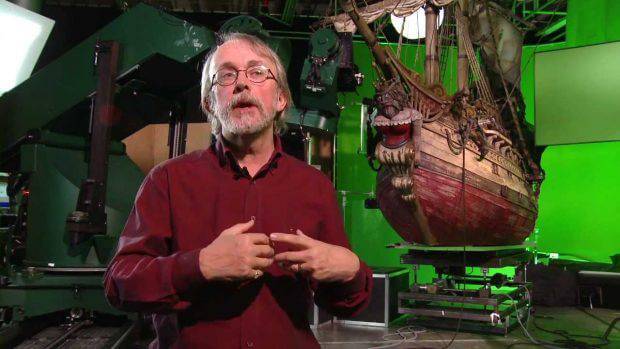
Peter Lord with the giant miniature ship used in The Pirates! In an Adventure with Scientists! (2012)
The 3-year deal with Sony was repeated in 2010. During this time Aardman co-founder Peter Lord was back in the Director’s chair for the first time since Chicken Run. The Pirates! In an Adventure with Scientists! Was a comedic adventure on a larger scale than their previous films, with more environments, more background characters, and more visual effects than they had attempted before. By this time they were shooting with digital cameras, and had a more developed CG department. This allowed for CG set extensions, digital matte paintings, green screen compositing, CG background characters and even the sea they sail on was completely CG. At the beginning, the entire film was planned to be CG, as producer Julie Lockhart said- “With all the water and all the huge locations- in order to do it, you’d be best to do it in CGI, it just felt like that was the way to go. Then Pete wanted to look at what a set would look like, so that could be a guide to the CG world.” The physical set was so charming that they decided to move the production over to a mostly stop-motion process.
Pirates! Was a critical success and a decent financial success. However, it did not do as well as expected in the USA, and as a result marked the end of Aardman’s partnership with Sony Pictures Animation. 2012 was a big year for stop-motion feature animation. Of the 5 films nominated for the ‘Best animated feature’ Oscar, 3 were stop-motion animated- Pirates!, Frankenweenie, and ParaNorman (co-directed by Flushed Away’s Sam Fell).
Aardman partnered with StudioCanal to create their next feature, Shaun the Sheep, which was a considerably lesser risk than Pirates! or Arthur Christmas– it was a branded film based on their popular TV series, it was much cheaper to make than any of their previous films at only $25m, it was aimed at Shaun’s established family audience, and there was no dialogue, meaning they could easily distribute it internationally.
When it released in 2015, it paid off- the film did very well proportionally to it’s budget, was very highly regarded among fans and critics, and now a sequel is on the way.
Personally I’m a huge fan of the polished, high-budget stop films like Pirates!, but Shaun the Sheep was completely appropriate for it’s lower-key production. The limitations brought out the aspects that Aardman are famous for. Having the animation largely on “twos”, with very little CG effects immediately gave it the charming vibe of the studio’s 1990s work. The sheep’s wool bustled and boiled a bit due to the animators’ touch, and you could see brushstrokes and fingerprints in the models, not so much to be distracting, but enough to reinforce the lovely hand-made feel of The Wrong Trousers. The lack of dialogue also pushed for more visual humor, and put extra emphasis on the characters’ expressions, reminiscent of Gromit.

After a decade away from features, Nick Park is back to direct Early Man (due 2018)
In 2007, it was announced that Nick Park was developing a non-Wallace and Gromit feature. It only just went into production this year. Early Man is due for release in January 2018, continuing the studio’s relationship with StudioCanal.
Aardman were the reason I took interest in animation in the first place, and I know they had the same effect on many others my age. I remember doing extra chores as a kid to save up for the “Cracking Animation” book, hassling my Mum to get me the “Aardman Classics” shorts DVD, writing to Merlin Crossingham as a student(not that long ago), and finally meeting David Sproxton and Pete Lord at Encounters and CTN last year.
I can’t think of a more unanimously liked studio, and I’m tremendously grateful for their many great contributions to the medium. Bravo, and Happy 40th anniversary, Aardman!



